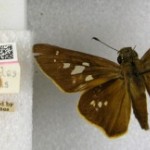Predatory Plant: Lure of the Cobra Lily
LINK TO VIDEO
http://blogs.kqed.org/science/video/predatory-plant-lure-of-the-cobra-lily/
“It seems strange to us that a plant can be carnivorous,” said Barry Rice, a botanist at the University of California, Davis Center for Plant Diversity. “We’ve gotten used to what we think of as a natural order of things, where people and animals eat plants, not the other way around.”

Butterfly Valley, located Plumas Nationa Forest, is one of the only protected cobra lily habitats. Photo by Josh Cassidy/KQED.
Drudging through the soggy fen recently, Rice said: “In habitats like this, where there are very few nutrients, carnivorous plants act as the top predator of the ecosystem. And they’ll eat just about anything they can lure into them.”
The plants entice insects into their pitcher-shaped traps with an offering of sugary nectar on their long leafy fangs. Insects that land on the plants gorge on the nectar, which leads them to the cobra lillies’ downward facing openings.

The
entrance to the cobra lily’s pitcher trap is curled inwards making it
easy for insects to enter, but difficult for them to find the exit once
inside. Photo by Josh Cassidy/KQED.
After buzzing around within the chamber and repeatedly slamming into the fenestrations, some unlucky insects fall or crawl down into the pitcher’s descending tube. The tube is lined with tiny downward facing hairs to discourage the insects from crawling back up to safety.
Exhausted, the insects eventually drown in the puddle of fluid at the bottom of the pitcher. Symbiotic midge larvae and bacteria living in the fluid, assist the cobra lily in digesting the doomed bugs. The plant then absorbs the nutrients through cells that line the inside of the pitcher tube, much the same way that roots absorb nutrients and water from the soil.
Carnivorous plants like the cobra lily still collect energy from the sun. But plants also require nutrients, and not all habitats have ideal nutrients in the soil. Carnivorous plants have evolved an alternative method of absorbing the essential nutrients. Instead of depending entirely on their roots to draw nitrogen and phosphorus up from the soil, carnivorous plants can supplement their input by absorbing the nutrients from the carcasses of their insect prey.
By adopting this alternative method of nutrition, the cobra lily is able to thrive in habitats that might otherwise be hostile to plant growth. The plant’s unusual affinity for frigid water and hot sun also make it a poor choice for carnivorous plant enthusiasts hoping to keep a cobra lily at home, since the plant’s preferred habitat is extremely difficult to recreate. Cobra lilies also receive federal protection in Butterfly Valley Botanical Area, so taking one home is not permitted. Those interested in growing carnivorous plants can check out Rice’s book, Growing Carnivorous Plants, or make a visit to California Carnivores, a carnivorous plant shop in Sebastopol, CA.
While carnivorous plants seem exotic, North America is actually home to lots of predatory plants.
“Many people think that carnivorous plants are only found in the tropics,” said Rice. “They don’t know that North America’s a hotspot for carnivorous plants. These Darlingtonia, for example, are only found in California and Oregon. The Venus flytrap is from North and South Carolina. So we have a lot of impressive carnivorous plant biodiversity in the United States.”

























No comments:
Post a Comment
Please leave a comment-- or suggestions, particularly of topics and places you'd like to see covered